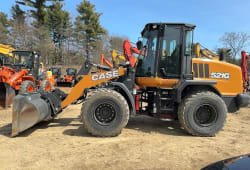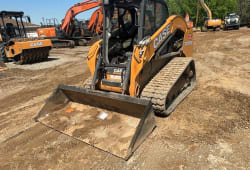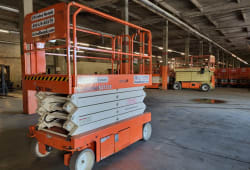Understanding Chassis Inspections for Heavy Equipment
10 Min read
)
November 17, 2023
Mario Ramirez, an expert heavy equipment inspector at Boom & Bucket, shares his deep expertise in heavy equipment inspection so you can make better buying decisions.
Chassis inspections play a vital role in keeping heavy equipment safe, efficient, and durable. By regularly examining the chassis, operators can ensure that the equipment is in optimal condition and prevent potential breakdowns that could lead to costly repairs and downtime. This article will provide a comprehensive guide to understanding chassis inspections for heavy equipment, covering the importance of these inspections, the basics of chassis construction, the inspection process, common issues found during inspections, and how to interpret inspection results.
The Importance of Chassis Inspections
Chassis inspections are crucial for maintaining safety and efficiency in heavy equipment operations. By regularly inspecting the chassis, operators can identify any potential issues or abnormalities that may compromise the equipment's stability and performance. This proactive approach helps to prevent accidents and ensures that the equipment operates at its full potential.
Ensuring Safety and Efficiency
One of the primary benefits of chassis inspections is ensuring the safety of operators and those working around the equipment. By inspecting the chassis, operators can identify any structural weaknesses, cracks, or damage that could affect the stability of the equipment. Timely repairs or replacements of damaged components are essential for maintaining safe operation.
In addition to safety, chassis inspections also contribute to the efficiency of heavy equipment. By regularly examining the chassis, operators can detect any issues that may increase fuel consumption or decrease overall performance. Addressing these problems promptly helps to optimize the equipment's productivity and reduce operational costs.
Furthermore, chassis inspections allow operators to assess the condition of various components such as suspension systems, steering mechanisms, and braking systems. These inspections help identify any wear and tear, loose connections, or signs of impending failure. By catching these issues early on, operators can prevent costly breakdowns and ensure smooth and reliable operation.
Prolonging Equipment Lifespan
Chassis inspections also play a crucial role in extending the lifespan of heavy equipment. By identifying and addressing issues early on, operators can prevent further damage and potential breakdowns that may result in costly repairs or even the need for a complete equipment replacement. Regular inspections and maintenance help to maximize the operational life of the equipment, ensuring a higher return on investment.
Moreover, during chassis inspections, operators can also assess the condition of the equipment's frame and body. This includes checking for signs of corrosion, rust, or structural damage. By promptly addressing these issues, operators can prevent further deterioration and ensure the longevity of the equipment.
Additionally, chassis inspections provide an opportunity to evaluate the effectiveness of the equipment's lubrication and cooling systems. Proper lubrication is vital for reducing friction and wear on moving parts, while efficient cooling systems prevent overheating and potential damage to the engine. Regular inspections allow operators to identify any deficiencies in these systems and take corrective measures to maintain optimal performance.
Furthermore, chassis inspections can also uncover opportunities for equipment upgrades or modifications. By closely examining the chassis, operators may identify areas where enhancements can be made to improve overall performance, safety, or efficiency. These upgrades could include the installation of additional safety features, improved suspension systems, or more fuel-efficient components.
In conclusion, chassis inspections are an essential aspect of heavy equipment maintenance. They ensure the safety of operators, contribute to the efficiency of operations, and prolong the lifespan of the equipment. By conducting regular inspections and addressing any issues promptly, operators can maximize the performance, reliability, and return on investment of their heavy equipment.
The Basics of Chassis in Heavy Equipment
Before diving into the specifics of chassis inspections, it's essential to understand the role of the chassis and its key components in heavy equipment.
Understanding the Role of the Chassis
The chassis serves as the foundation of heavy equipment, providing structural support and connecting various components such as the engine, transmission, and suspension systems. It is designed to withstand the heavy loads, vibrations, and impacts commonly encountered in challenging worksite conditions. The chassis also acts as a protective enclosure for sensitive components, shielding them from external elements.
Key Components of a Heavy Equipment Chassis
The chassis of heavy equipment comprises various components that work together to ensure optimal performance and durability. These include the frame, axles, suspension system, steering mechanism, and braking system. Each component plays a critical role in maintaining the stability and maneuverability of the equipment.
The Process of Chassis Inspection
Performing a thorough chassis inspection involves several steps, starting with pre-inspection procedures and concluding with detailed inspections of each component. Following a structured inspection process helps to ensure that no issues or abnormalities are overlooked.
Pre-Inspection Procedures
Prior to conducting a chassis inspection, it is essential to prepare the equipment and gather the necessary tools and documentation. This includes reviewing the manufacturer's guidelines, collecting inspection checklists, and ensuring that the equipment is clean and free from any obstructions that may impede the inspection process.
Furthermore, operators should inspect the surrounding area for any potential hazards or safety risks that may affect the inspection or subsequent repairs. This includes identifying unstable ground conditions, overhead obstructions, or other equipment that may pose a threat.
Once the equipment and the surrounding area have been prepared, operators should also ensure that they have the appropriate personal protective equipment (PPE) to carry out the inspection safely. This may include items such as safety glasses, gloves, and high-visibility vests.
Detailed Inspection Steps
When conducting the actual chassis inspection, operators should follow a systematic approach to ensure that all critical areas and components are thoroughly examined. This typically involves visually inspecting the frame, axles, suspension system, steering mechanism, and braking system for any signs of damage, wear, or abnormalities. It is essential to pay close attention to areas that are more prone to corrosion, such as joints or areas exposed to extreme weather conditions.
During the inspection, operators should document their findings, taking note of any issues or observations. They should also address any minor problems detected during the inspection to prevent them from developing into more significant issues in the future.
Inspectors may use various tools and equipment to aid in the inspection process. For example, they may use a flashlight to examine hard-to-reach areas or a mirror to inspect hidden components. They may also use specialized tools, such as a torque wrench, to ensure that bolts and fasteners are properly tightened.
In addition to visual inspections, operators may also perform functional tests to ensure that all components are operating correctly. This may involve testing the brakes, steering system, and suspension system to check for proper functionality and responsiveness.
Furthermore, inspectors may also conduct non-destructive testing (NDT) to assess the integrity of the chassis. NDT techniques, such as ultrasonic testing or magnetic particle inspection, can detect hidden defects or cracks that may not be visible to the naked eye.
After completing the inspection, operators should compile a comprehensive report detailing their findings. This report should include a summary of the inspection process, any issues or abnormalities detected, and recommendations for repairs or maintenance. The report should be shared with relevant stakeholders, such as maintenance personnel or management, to ensure that necessary actions are taken.
Regular chassis inspections are crucial for maintaining the safety and reliability of equipment. By following a structured inspection process and paying attention to detail, operators can identify and address potential problems before they escalate, minimizing downtime and ensuring optimal performance.
Common Issues Found During Chassis Inspections
Chassis inspections often reveal a range of common issues that operators should be aware of. By identifying these problems early on, operators can take the necessary steps to address them before they cause further damage or compromise the equipment's performance.
Structural Damage and Wear
Heavy equipment is subject to constant wear and tear, which can result in structural damage over time. Common issues in this category include cracks, dents, or bends in the frame or other load-bearing components. It is crucial to identify these issues promptly, as they can compromise the stability and safety of the equipment.
During chassis inspections, operators should pay close attention to any signs of structural damage. This includes thoroughly examining the frame for any visible cracks or fractures. Additionally, checking load-bearing components such as axles, suspension systems, and steering mechanisms is essential to ensure their integrity.
Furthermore, wear and tear on the chassis can manifest in various ways. Operators should inspect the equipment for any signs of excessive rust, which can weaken the metal and lead to structural issues. They should also look out for dents or bends that may have occurred due to collisions or heavy impacts.
Addressing structural damage and wear promptly is crucial for maintaining the equipment's performance and preventing further deterioration. Depending on the severity of the issue, repairs may range from simple fixes like welding or reinforcing the affected area to more extensive measures such as replacing the damaged components.
Corrosion and Rust
Corrosion and rust are common challenges faced by heavy equipment operating in environments with high humidity, saltwater exposure, or extreme temperature variations. These issues often affect the chassis and other metal components, weakening their structural integrity and leading to premature failure. Regular inspections and appropriate protective measures are essential for mitigating the effects of corrosion and preserving the equipment's lifespan.
During chassis inspections, operators should thoroughly examine the equipment for any signs of corrosion or rust. This includes checking the chassis, as well as other metal components such as the body, engine parts, and hydraulic systems. Areas prone to corrosion, such as joints, seams, and areas exposed to moisture, should receive extra attention.
Preventive measures can help minimize the effects of corrosion and rust. Applying protective coatings or paints specifically designed for heavy equipment can provide an additional layer of defense against moisture and corrosive substances. Regular cleaning and maintenance, including removing dirt, debris, and salt residue, can also help prevent the buildup of corrosive agents.
In cases where corrosion or rust has already occurred, operators should take immediate action to prevent further damage. This may involve removing the affected areas, treating them with rust inhibitors, and applying protective coatings to prevent future corrosion.
By addressing corrosion and rust issues proactively, operators can extend the lifespan of their equipment and reduce the risk of costly repairs or premature equipment failure.
Interpreting Inspection Results
Once the chassis inspection is complete, operators need to interpret the inspection results accurately to make informed decisions regarding maintenance and repairs.
Understanding Inspection Reports
Chassis inspection reports provide a comprehensive overview of the equipment's condition, including any issues or abnormalities detected during the inspection. These reports typically contain detailed descriptions of the problems, along with recommendations for repairs or replacements. Operators should carefully review inspection reports and consult with qualified technicians or engineers to fully understand the implications of the findings.
Making Informed Maintenance Decisions
Based on the inspection results, operators can make informed decisions regarding maintenance and repairs. This may include scheduling necessary repairs, replacing worn-out components, or implementing preventive maintenance measures to minimize future issues. By taking prompt action based on inspection results, operators can ensure that their heavy equipment remains safe, efficient, and reliable.
In conclusion, understanding chassis inspections for heavy equipment is essential for maintaining safety, efficiency, and prolonging equipment lifespan. By recognizing the importance of these inspections, familiarizing oneself with the basics of chassis construction, following a structured inspection process, identifying common issues, and interpreting inspection results accurately, operators can effectively manage their heavy equipment and ensure optimal performance in challenging worksite conditions.

Caleb Woods is an experienced content specialist and an editor at Boom & Bucket, blending his journalism background with expertise in the heavy equipment industry. He delivers engaging, informative content to help professionals stay informed and make smarter decisions in the machinery market.











